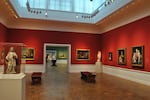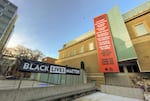Closing a major art museum isn’t nearly as simple as turning out the lights and locking the doors. Protecting fragile, priceless works of art is a full-time responsibility: even if a pandemic pops up and spoils your plans.
So when COVID-19 forced the Portland Art Museum to shutter its doors last year, director and chief curator Brian Ferriso said there was still a lot of work to do.
“Our bills don’t stop when we close,” Ferriso said. “We still have climate control systems; we have a number of things that are in place like security that still have to be in place 24/7.”
It’s been a year of quick pivots and hard choices for the 129-year-old institution. The museum had to close its doors to the public completely two times: once in the spring and again in November 2020. During the months when it could, it operated at a fraction of its normal capacity: at one point, when Multnomah County was in the ‘extreme risk’ category, state regulations required the museum to permit only six guests at a time — this is inside a building with more than 112,000 feet of gallery space and an official capacity of nearly 2,900 people.

The Portland Art Museum
Courtesy of the Portland Art Museum
Like many cultural institutions, the Portland Art Museum had to respond with drastic cuts. The museum slashed its budget by 40% last year. It furloughed and then laid off a significant number of its employees. Without revenue from ticket sales and event space rentals coming in, the cuts were simply unavoidable.
“I’d say across the board, museums are under-capitalized,” Ferriso said. “We have huge amounts of fixed costs, we have very important collections to take care of, we have significant staff that really make our museum what it is today.”
A slow return to normalcy
Today, things are looking much brighter for the museum. It’s once again able to admit 50% guest capacity now that Multnomah County has dropped to the ‘lower risk’ category. The museum is hiring back staff and ramping up programming. It even has a much-anticipated (and twice-delayed) exhibition of the work of iconic western photographer Ansel Adams on display now.
But it’s not back to business as usual on the park blocks, yet. Last week, the Portland Art Museum signed a pledge along with 13 other cultural institutions across the Portland region to continue requiring patrons to wear masks for the time being. Ferriso said that, as eager as the museum is to get back to normal, he doesn’t want to rush it either: “We felt, why not take this step and be a little more conservative, continue to implement that policy together as a community. It really has been really helpful for all of us: our organizations, and my staff, and the public feeling a level of comfort.”
Ferriso said part of the decision is based on the museum’s responsibility to the revitalization of downtown Portland, where foot traffic has evaporated over the past year. He said cultural institutions like the Portland Art Museum have a special role in that healing: both as a business, but also as a restorative symbol of our cultural ideals.
“We feel privileged and understand the responsibility that we have as an organization,” he said: “Especially one that is about inspiration, hope and our shared humanity.”
Reckoning with a past history of oppression
As disruptive as the pandemic has been, the biggest change the museum’s undertaking might be the reckoning that the past year’s racial and social justice movements have caused for the institution. Founded in 1892, museum officials often note that the institution was born ‘in the Gilded Age.’

European art at the Portland Art Museum
Portland Art Museum
Ferriso acknowledged that, like many fine art institutions of its age, the museum’s collection is full of works that celebrate a white, Euro-centric view of art history.
“Many of those collections throughout history have been acquired in ways that are more oppressive to others,” he said. “Whether it’s countries colonizing other countries and taking works of art or the church supporting certain aspects of patronage. We need to think critically about how these collections need to be and why they’ve been celebrated.”
Ferriso acknowledges that the curatorial decisions the museum has made over the years have continued to marginalize artists that don’t fit into the mainstream tradition of art, and that “entire swaths” of the museum are lacking a diverse representation of artists today.
“In the 20th century alone,” he said, “the number of artists work in the field—let’s just say abstract expressionism—we have a very narrow perspective of representation of artists working at the time. For example, we don’t have a great Norman Lewis,” a Black painter who was an important member of the Abstract Expressionism movement who explored the social issues of the Civil Rights era in his work. “We don’t have a Norman Lewis. There are many other artists that we want representation of on the walls.”
But the Portland Art Museum is trying to change. Last June, the museum put out a statement in solidarity with the protests movements that began after George Floyd’s death, stating:
“We also recognize our own museum’s role in supporting systems of oppression and inequity over a 127-year history, and pledge to continue our commitment to listen…to learn…to be accountable to our shared humanity…to be a civic space doing the necessary and urgent work of antiracism and contributing to a more just and equitable society.”
Ferriso said the museum is making a concerted effort to add more works by marginalized artists to its collection. “It starts with our staff, who we hire, how they’re researching, how our curators are thinking about collection development, how we’re looking at where to buy works of art,” he said.
It’s also about taking internal equity work seriously. The museum has begun hosting affinity groups for Black, Indigenous and People of Color (BIPOC) employees, and white learning space groups for people to discuss race and racial equity at work.
The museum also said its also looking for new ways the Portland Art Museum can support the artistic community here in the Pacific Northwest. During the depths of the pandemic, it launched several rounds of artist relief grants and deepened its partnership with The Numberz FM, a Black-led community radio station in Portland. The museum is planning a number of shows focusing on PNW artists, including an exhibition “The Black Artists of Oregon” in October 2022 that will be guest curated by Portland artist Intisar Abioto.
A place for hope

Portland Art Museum exterior: part of artist Carrie Mae Weems’ public art/public health campaign “Resist COVID/Take 6,” drawing attention to the disproportionate impact of the coronavirus pandemic on Black, Latinx and Native American communities.
Portland Art Museum
Ferriso said the multiple reckonings of the last year are forcing the Portland Art Museum to think more deeply about its role within the community — and where it still has a lot to learn. “It’s accelerated our need to be very responsive to the community that we’re in. We need it to be of the community and not just in it.”
But ultimately, as spring turns into summer and we begin to remember the easy joys of communal spaces, he hopes the Portland Art Museum can be a refuge for a community that’s suffered too much, in too many ways, over the last 15 months.
“I think a museum is about hope,” he said. “A place to take the mind to different places. So being a place where people can find joy and hope and contemplation is so important right now.”
Listen to Portland Art Museum Director Brian Ferriso’s conversation with OPB Weekend Edition host John Notarianni using the audio player above.
Correction: This story has been updated with the correct date of the opening of the exhibition “The Black Artists of Oregon.”
